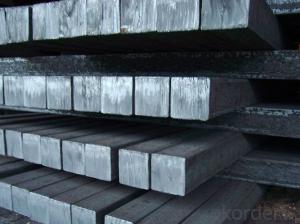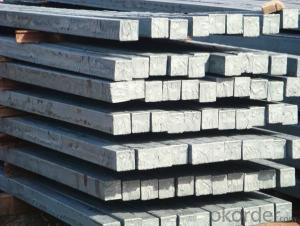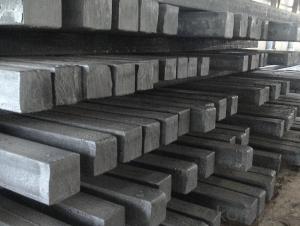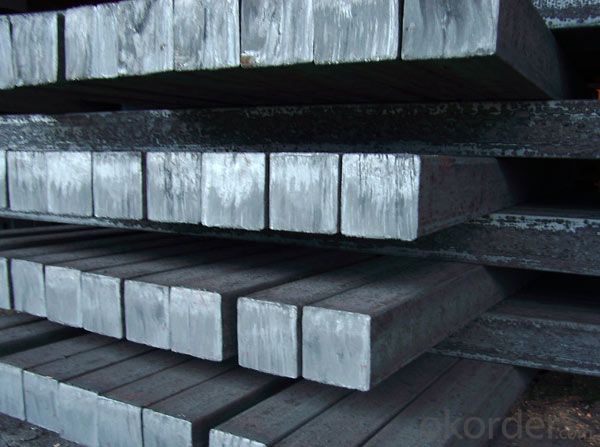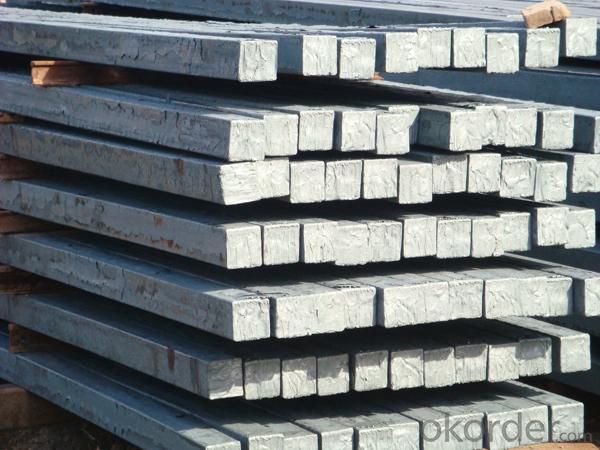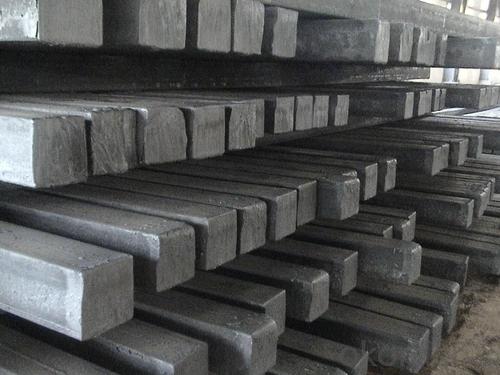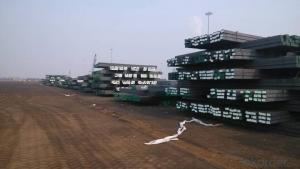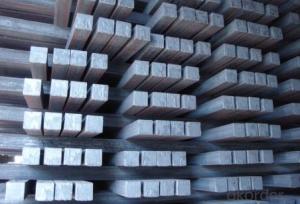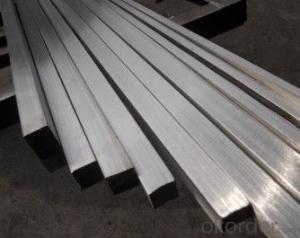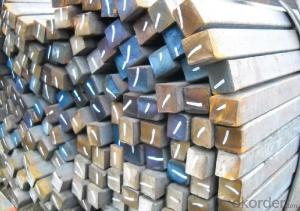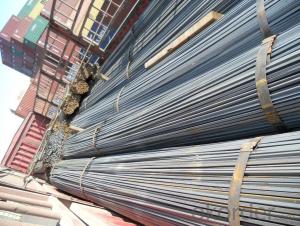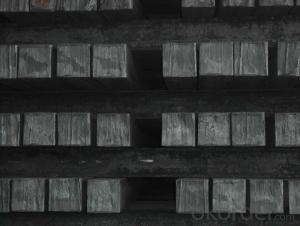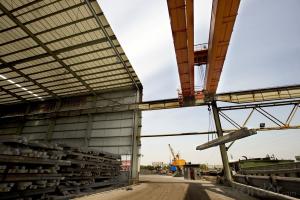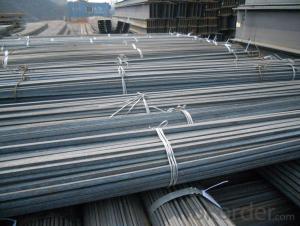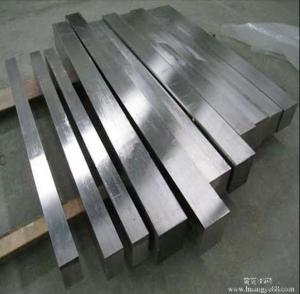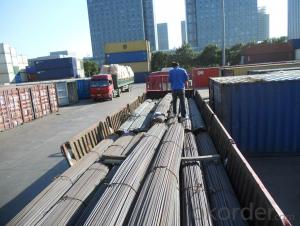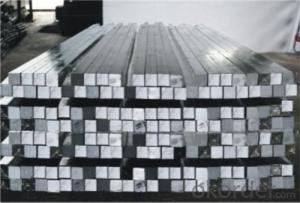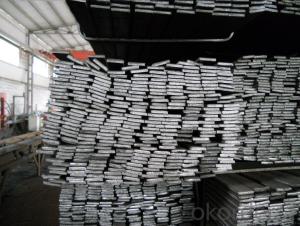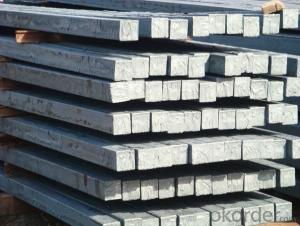hot rolled square bar
- Loading Port:
- China Main Port
- Payment Terms:
- TT OR LC
- Min Order Qty:
- -
- Supply Capability:
- -
OKorder Service Pledge
OKorder Financial Service
You Might Also Like
Square Bar Details:
| Minimum Order Quantity: | | Unit: | m.t. | Loading Port: | |
| Supply Ability: | | Payment Terms: | | Package: | loose |
Product Description:
1.Heat the EVA film
2.Cover the heated EVA film on the mould(can be made from wood or aluminum)
3.Spray a coating in a certain baume degree
4.Put on the empty blask
5.Sand-up the flask and vibrate to compaction
Packaging & Delivery
Packaging Details:containers
Delivery Detail:Complete one set of equipment needs for three months
-The length of a side and the theoretical weight of Square Steel.
Length of a side(a, mm) | Theoretical weight(kg/m) | Length of a side(a, mm) | Theoretical weight(kg/m) |
6 | 0.283 | 32 | 8.04 |
7 | 0.385 | *33 | 8.55 |
8 | 0.502 | 34 | 9.07 |
9 | 0.636 | *35 | 9.62 |
10 | 0.785 | 36 | 10.17 |
11 | 0.950 | 38 | 11.24 |
12 | 1.13 | 40 | 12.56 |
13 | 1.33 | 42 | 13.85 |
14 | 1.54 | 45 | 15.90 |
15 | 1.77 | 48 | 18.09 |
16 | 2.01 | 50 | 19.63 |
17 | 2.27 | 53 | 22.05 |
18 | 2.54 | *55 | 23.6 |
19 | 2.82 | 56 | 24.61 |
20 | 3.14 | *58 | 26.4 |
21 | 3.46 | 60 | 28.26 |
22 | 3.80 | 63 | 31.16 |
*23 | 4.15 | *65 | 33.17 |
24 | 4.52 | *68 | 36.3 |
25 | 4.91 | 79 | 38.49 |
26 | 5.30 | 75 | 44.16 |
*27 | 5.72 | 80 | 50.24 |
28 | 6.15 | 85 | 56.72 |
*29 | 6.60 | 90 | 63.59 |
30 | 7.06 | 95 | 70.85 |
*31 | 7.54 | 100 | 78.50 |
Notes:
1, The theoretical weights in the list, base on the density of 7.85 g/cm3.
2, The numbers with *mean that they are not regulars or we don’t offer them.
-The allowed tolerance of Square Steel:
Length of a side(mm) | Allowed Tolerance | ||
Group1 | Group2 | Group3 | |
5.5~7 | ±0.20 | ±0.30 | ±0.40 |
7~20 | ±0.25 | ±0.35 | ±0.40 |
20~30 | ±0.30 | ±0.40 | ±0.50 |
30~50 | ±0.40 | ±0.50 | ±0.60 |
60~80 | ±0.60 | ±0.70 | ±0.80 |
80~110 | ±0.90 | ±1.0 | ±1.1 |
110~150 | ±1.2 | ±1.3 | ±1.1 |
150~190 | ―― | ―― | ±2.0 |
190~250 | ―― | ―― | ±2.5 |
Usage/Applications of Steel Square Bar:
-The Square Steel is normally used as structure steel.
-Row material for other structure steel like steel angles, channels, I-beams, H-beams, etc…
Packaging & Delivery of Steel Square Bar:
-Packing Detail: The products can be packed in bundles by steel wires.
-Marks:
1, Tag marks: the tag marks will be tied up to each bundle of the products. The information is usually including supplier’s logo and name, product name, made in China, products’ specifications, the painted color and other information requested by customers.
2, Color marks: we will paint both ends of the bundles of these products to make sure that they are more evident. It’s will be more convenient for the customers to distinguish them at the destination port.
-Delivery Detail: 30~45 working days after receive buyer’s T.T. or L/C.
Transportation:
-The products can be delivered by bulk vessel or by container. As for container, products with the length of 6m will be loaded in 20’ container, with 9m or 12m, in 40’ container.
-The maximum quantity of loading of container is 25 tons.
-The products usually are transported to the nearest port from the production place.
Payment:
-Invoicing on theoretical weight or actual weight a s customer’s request.
-FOB, CFR or CIF.
-Regular terms of payment:
1, 30% payment in advance, the remaining balance (70% payment) against the copy of B/L.
2, 30% payment in advance, the remaining balance (70% L/C) against the copy of B/L.
3, Negotiable.
- Q: How do you use a steel square to determine the length of a miter cut?
- To use a steel square to determine the length of a miter cut, you can follow these steps: 1. Start by placing the steel square on the edge of the material that needs to be cut at a 45-degree angle. Ensure that one arm of the square is aligned with the edge of the material. 2. Once the square is properly aligned, use a pencil or a scribe to mark along the other arm of the square. This will create a line on the material that represents the angle of the miter cut. 3. Measure the length of this line using a tape measure or a ruler. This measurement represents the length of the miter cut. 4. Transfer this measurement to the material that needs to be cut. Mark the length on the material using the pencil or scribe. 5. Double-check the alignment of the steel square and the marked line to ensure accuracy. Make any necessary adjustments before proceeding with the cut. 6. Using a saw suitable for the material, cut along the marked line to create the miter cut. By using a steel square in this manner, you can accurately determine the length of a miter cut and ensure that your material is cut at the desired angle.
- Q: Can a steel square be used for fence gate installation?
- Yes, a steel square can be used for fence gate installation. It can be used to ensure accurate measurements and angles during the installation process.
- Q: The difference between galvanized square and galvanized steel
- Hello, SECC is a hot-rolled or cold-rolled galvanized steel or galvanized sheet for the blank shape by the cold bending process after section steel pipe welded square hollow square cross-section shape and size of the high-frequency; galvanized square cold-formed steel hollow or well in advance of the hot dip galvanized after processed tube.Galvanized square steel: first the steel bar is solid. Different from the square pipe, hollow, belong to the pipe. The steel surface is galvanized, galvanized steel.
- Q: How does a steel square assist in determining the correct angle for a half-blind dovetail joint?
- A steel square assists in determining the correct angle for a half-blind dovetail joint by providing a precise and accurate measurement tool. It allows woodworkers to align the square with the edges of the wood to ensure that the angle of the joint is exactly 90 degrees. This helps in achieving a clean and tight fit for the half-blind dovetail joint, ensuring a strong and sturdy connection between the pieces of wood.
- Q: Can a steel square be used for measuring angles other than right angles?
- No, a steel square cannot be used for measuring angles other than right angles. A steel square, also known as a try square or a carpenter's square, is specifically designed to measure right angles accurately. It consists of a metal blade with a handle at a right angle, forming an L-shape. The purpose of a steel square is to check the squareness of corners, mark right angles, and ensure accurate 90-degree angles in carpentry and other construction work. While it may be possible to estimate or approximate other angles using a steel square, it is not a reliable or precise tool for measuring angles other than right angles. For measuring angles of different degrees, specialized tools such as protractors or angle finders should be used.
- Q: How do you use a steel square to determine angles for wainscoting?
- To use a steel square to determine angles for wainscoting, start by placing the square flat against the wall and aligning one edge with the baseboard. Then, rotate the square until the other edge aligns with the desired angle for the wainscoting. Once the square is in the correct position, mark the angle on the wall using a pencil or a small level. This marked angle will serve as a guide for cutting the wainscoting pieces at the correct angle before installation.
- Q: How do you use a steel square to measure and mark 180-degree angles?
- To measure and mark 180-degree angles using a steel square, the following steps should be followed: 1. Position the steel square onto the surface or material where the angle needs to be measured. 2. Align one side of the square with a reference line or edge of the material. 3. Ensure that the right-angle corner of the square is placed at the starting point of the desired angle. 4. Rotate the square until the other side aligns with the intended direction of the angle. 5. Firmly hold the square in place once the desired angle is achieved. 6. Trace along the edge of the square using a pencil or marker to mark the 180-degree angle. 7. Remove the steel square, and the material will now bear a precise 180-degree angle marking. It is crucial to remember that a steel square is specifically designed for measuring and marking right angles (90 degrees). In order to measure and mark 180-degree angles, the right-angle corner of the square must be utilized and aligned accordingly to achieve the desired angle.
- Q: How do you use a steel square to lay out a sliding dovetail joint?
- To use a steel square to lay out a sliding dovetail joint, follow these steps: 1. Start by marking the centerline of both the sliding dovetail socket and the sliding dovetail tail on your workpiece. This can be done using a marking gauge or a sharp pencil. 2. Place the steel square against the edge of the tail piece, aligning it with the centerline mark. The long side of the square should be parallel to the edge of the workpiece. 3. Use a pencil or a sharp knife to mark the shoulder line on the tail piece. The shoulder line represents the depth of the dovetail socket. 4. Similarly, position the steel square against the edge of the socket piece, aligning it with the centerline mark. Again, the long side of the square should be parallel to the edge of the workpiece. 5. Mark the shoulder line on the socket piece, ensuring that it aligns with the previously marked line on the tail piece. 6. Now, using the square, mark the angled sides of the dovetail on both the socket and tail pieces. Place the square on the edge of the tail piece so that it aligns with the shoulder line. Then, draw lines along both edges of the square to create the angled sides of the dovetail. 7. Repeat the same process on the socket piece, aligning the square with the shoulder line and marking the angled sides of the dovetail. 8. Once you have marked the socket and tail pieces, you can proceed to cut the dovetail joint using a saw, chisel, or router, depending on your preference and the tools available to you. Remember to take your time and double-check all measurements and markings before making any cuts to ensure a precise and snug-fit sliding dovetail joint.
- Q: Can a steel square be used for checking the squareness of a jointer table?
- Yes, a steel square can be used for checking the squareness of a jointer table. A steel square is a tool commonly used in woodworking to verify the accuracy of right angles. By placing the steel square against the jointer table, you can determine if it is perfectly perpendicular to the fence or bed of the jointer. If the table is square, the steel square should fit snugly against both surfaces, indicating that the jointer table is properly aligned. If there is a gap or the square does not sit flush against the table, it indicates that the jointer table is not square and may require adjustments. However, it is important to note that while a steel square can provide a general assessment of squareness, for precise measurements and alignments, other tools such as precision squares or dial indicators may be more appropriate.
- Q: Can a steel square be used for gate post layout and installation?
- Gate post layout and installation can be achieved using a steel square. This tool, also referred to as a framing square or carpenter's square, is extensively employed in construction and woodworking projects due to its versatility. Its design consists of a long, straight edge coupled with a shorter perpendicular blade, forming an "L" shape. By utilizing the elongated edge of the steel square, gate posts can be accurately marked and positioned. Furthermore, it serves the purpose of measuring angles and ensuring the gate posts are installed at the appropriate level and alignment. Moreover, during the installation process, the steel square can be utilized to assess the squareness and plumbness of the gate posts, guaranteeing a robust and well-aligned gate. Ultimately, the steel square proves to be a valuable and precise tool for gate post layout and installation, contributing to the construction process with accuracy and precision.
Send your message to us
hot rolled square bar
- Loading Port:
- China Main Port
- Payment Terms:
- TT OR LC
- Min Order Qty:
- -
- Supply Capability:
- -
OKorder Service Pledge
OKorder Financial Service
Similar products
Hot products
Hot Searches
Related keywords
